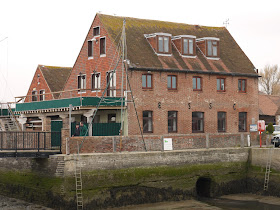Chichester Harbour
I had an opportunity for a day's outing today and after some thought and research I found that I could progress two separate projects. A couple of years ago, when we were walking the Berkshire Way, we walked along a delightful section of the Wayfarer's Walk. The Hampshire County Council and Long Distance Walkers Association websites quickly revealed that this runs from Inkpen Beacon in Berkshire 71 miles south to Emsworth in Hampshire. The Emsworth Online website suggested that this previously unknown town near Portsmouth was worth a visit. Obviously it failed the Mandy Rice-Davies test (it would say that, wouldn't it?), but I thought it was worth checking out as a prelude to hopefully doing the walk.
More recently, having just walked around the splendid RSPB reserve at Arne, I was keen to see more. It turned out that there is a much smaller reserve at Pilsey Island, off Thorney Island, which is near .... Emsworth. So the plan for the day was born. Thorney was a true island until the late 19th century when it was joined to the mainly by creating a sea wall around what is now low-lying land.
I parked at the end of the pretty village of Pilsden and set off along the eastern side of Thorney Island, with one of the many arms of Christchurch Harbour to my left. Almost immediately I spotted a lone Redshank, standing stock-still by the shoreline.
The path goes through a boat yard and then meanders around the side the shallow marshy-looking harbour. A few more lone Redshanks were spotted, along with many Brent Geese and a few Egrets.
There were a few more serious birders along here. One told me that Short-eared Owls had been seen in nearby trees and some Sand Martins had been spotted too. Another asked what I had seen. It was nice to be taken for a birder, but when I mentioned the Redshanks, I received a small smile and the information that they were "common around here". I had definitely been found out.
Soon you reach a gate in a high wire fence where you have to use an entryphone to continue along the path as it enters MOD land. Further on you reach West Thorney village, surprisingly named since it is one the east side of the island. It is still within the MOD land, unexpectedly possesses the charming 12/13th century church of St Nicholas. Pevsner reveals that it originally had two aisles, but these were removed in the early 17th century. Some lancet windows were repositioned in the nave making it look as though it has been built in the way you see it today. There is also a Norman priest's door.
You now have to walk alongside the base proper, and to escape this I headed closer to the back of the shoreline. Eventually I approached Longmere Point, from where a narrow spit of land connects to Pilsey Island. In truth this was all rather anticlimactic. The island is small, flat and largely featureless. Its key role is as a safe haven for birds and other wildlife to live undisturbed by man; I already knew that you couldn't visit it. In principle, you can observe the birds from the sandbank, but by now the tide was a long way out and all that immediately met the eye was mud.
I was lucky enough to get a close up of a lone Black-tailed Godwit in a pool behind the shoreline ...
... but most of the rest of the large number of wading birds were too far away to be seen. This telephoto picture shows some of the many Brent Geese I saw, with unknown other smaller birds around them.
I didn't realise it at the time, but the picture also shows two people walking their dog on East Head at West Wittering beach in the background.
I turned and headed back. I was amused this time to see a footpath sign apparently pointing out to sea.
It meant - perhaps obviously - that the path followed the edge of the shore. The tide had gone out even further now and what had been water on the way out was now mud. I did see a number of Oystercatchers and Curlews however. Also common of course.
I wondered afterwards whether this was an exceptionally low tide caused by the "supermoon" of 20 March: the moon was full at almost the exact moment it was at its closest point to earth in the last 18 years.
When I got back to the car I was a bit weary so I drove into Emsworth - I had intended to walk. There, after a restorative lunch in the excellent Coal Exchange pub I made a quick tour.
Map: Explorer 120 (Chichester).
Conditions: cloudy, cool.
Distance: about 6 miles.
Rating: three and a half stars.
Emsworth
I started in the Square and admired the small, delicate presumably Georgian, former town hall.
I walked along Nile St down to the large Town Millpond - not very photogenic without any water. I followed the waterline so far as possible and emerged by the main harbour where the former tidal mill has now been converted into a yacht club HQ.
I walked back up South Street past the pub and back through the Square to turn right into Queen Street. Just off to the right was King St, with an interesting collection of houses of various ages. I especially liked these two pairs of early 19th century semis.
Further down Queen St, I came on this fine flour mill of 1897. Pevsner's praise is rather faint: he calls it a "straightforward and pleasing small-town industrial building".
Just beyond it was the town's other mill pond, Slipper Mill Pond, which did at least have some water.












No comments:
Post a Comment